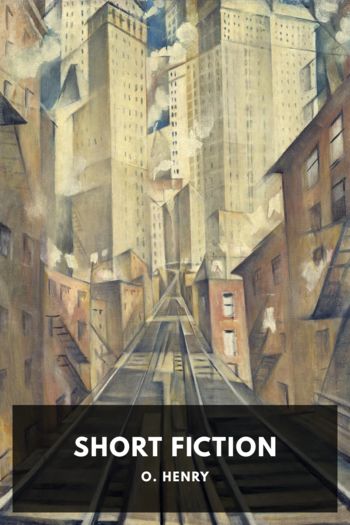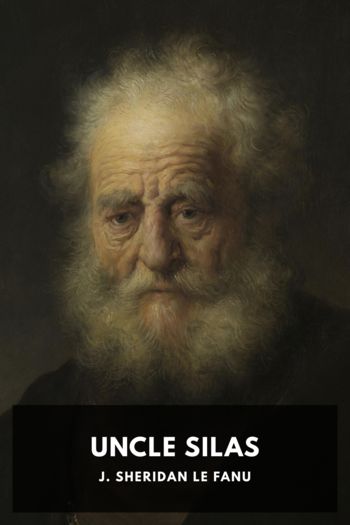Short Fiction, O. Henry [best books to read for teens TXT] 📗

- Author: O. Henry
Book online «Short Fiction, O. Henry [best books to read for teens TXT] 📗». Author O. Henry
“You’re a dandy,” said he. “And I don’t blame you for being careful. I don’t mind telling you. I got wet. I was on a North River ferry a few days ago when a girl jumped overboard. Of course, I—”
Hetty extended her hand, interrupting his story.
“Give me the onion,” she said.
The young man set his jaw a trifle harder.
“Give me the onion,” she repeated.
He grinned, and laid it in her hand.
Then Hetty’s infrequent, grim, melancholy smile showed itself. She took the young man’s arm and pointed with her other hand to the door of her room.
“Little Brother,” she said, “go in there. The little fool you fished out of the river is there waiting for you. Go on in. I’ll give you three minutes before I come. Potatoes is in there, waiting. Go on in, Onions.”
After he had tapped at the door and entered, Hetty began to peel and wash the onion at the sink. She gave a gray look at the gray roofs outside, and the smile on her face vanished by little jerks and twitches.
“But it’s us,” she said, grimly, to herself, “it’s us that furnished the beef.”
Thimble, ThimbleThese are the directions for finding the office of Carteret & Carteret, Mill Supplies and Leather Belting:
You follow the Broadway trail down until you pass the Crosstown Line, the Bread Line, and the Dead Line, and come to the Big Canyons of the Moneygrubber Tribe. Then you turn to the left, to the right, dodge a pushcart and the tongue of a two-ton four-horse dray and hop, skip, and jump to a granite ledge on the side of a twenty-one-story synthetic mountain of stone and iron. In the twelfth story is the office of Carteret & Carteret. The factory where they make the mill supplies and leather belting is in Brooklyn. Those commodities—to say nothing of Brooklyn—not being of interest to you, let us hold the incidents within the confines of a one-act, one-scene play, thereby lessening the toil of the reader and the expenditure of the publisher. So, if you have the courage to face four pages of type and Carteret & Carteret’s office boy, Percival, you shall sit on a varnished chair in the inner office and peep at the little comedy of the Old Nigger Man, the Hunting-Case Watch, and the Open-Faced Question—mostly borrowed from the late Mr. Frank Stockton, as you will conclude.
First, biography (but pared to the quick) must intervene. I am for the inverted sugarcoated quinine pill—the bitter on the outside.
The Carterets were, or was (Columbia College professors please rule), an old Virginia family. Long time ago the gentlemen of the family had worn lace ruffles and carried tinless foils and owned plantations and had slaves to burn. But the war had greatly reduced their holdings. (Of course you can perceive at once that this flavor has been shoplifted from Mr. F. Hopkinson Smith, in spite of the “et” after “Carter.”) Well, anyhow:
In digging up the Carteret history I shall not take you farther back than the year 1620. The two original American Carterets came over in that year, but by different means of transportation. One brother, named John, came in the Mayflower and became a Pilgrim Father. You’ve seen his picture on the covers of the Thanksgiving magazines, hunting turkeys in the deep snow with a blunderbuss. Blandford Carteret, the other brother, crossed the pond in his own brigantine, landed on the Virginia coast, and became an F.F.V. John became distinguished for piety and shrewdness in business; Blandford for his pride, juleps; marksmanship, and vast slave-cultivated plantations.
Then came the Civil War. (I must condense this historical interpolation.) Stonewall Jackson was shot; Lee surrendered; Grant toured the world; cotton went to nine cents; Old Crow whiskey and Jim Crow cars were invented; the Seventy-ninth Massachusetts Volunteers returned to the Ninety-seventh Alabama Zouaves the battle flag of Lundy’s Lane which they bought at a secondhand store in Chelsea, kept by a man named Skzchnzski; Georgia sent the President a sixty-pound watermelon—and that brings us up to the time when the story begins. My! but that was sparring for an opening! I really must brush up on my Aristotle.
The Yankee Carterets went into business in New York long before the war. Their house, as far as Leather Belting and Mill Supplies was concerned, was as musty and arrogant and solid as one of those old East India tea-importing concerns that you read about in Dickens. There were some rumors of a war behind its counters, but not enough to affect the business.
During and after the war, Blandford Carteret, F.F.V., lost his plantations, juleps, marksmanship, and life. He bequeathed little more than his pride to his surviving family. So it came to pass that Blandford Carteret, the Fifth, aged fifteen, was invited by the leather-and-mill-supplies branch of that name to come North and learn business instead of hunting foxes and boasting of the glory of his fathers on the reduced acres of his impoverished family. The boy jumped at the chance; and, at the age of twenty-five, sat in the office of the firm equal partner with John, the Fifth, of the blunderbuss-and-turkey branch. Here the story begins again.
The young men were about the same age, smooth of face, alert, easy of manner, and with an air that promised mental and physical quickness. They were razored, blue-serged, straw-hatted, and pearl stick-pinned like other young New Yorkers who might be millionaires or bill clerks.
One afternoon at four o’clock, in the private office of the firm, Blandford Carteret opened a letter that a clerk had just brought to his desk. After reading it, he chuckled audibly for nearly a minute. John looked around from his desk inquiringly.
“It’s from mother,” said Blandford. “I’ll read you the funny part of it. She tells me all the neighborhood news first, of course,





Comments (0)